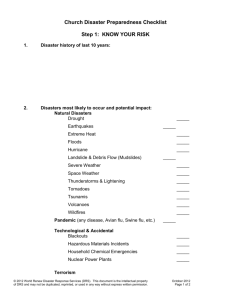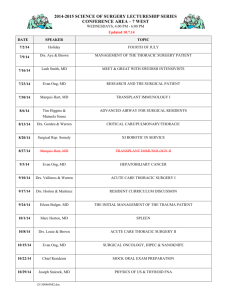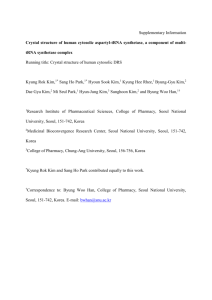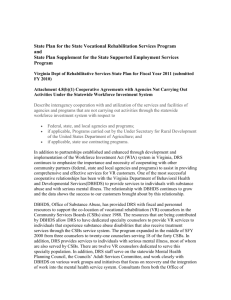Workforce Plan: Assessment of Current Needs
advertisement
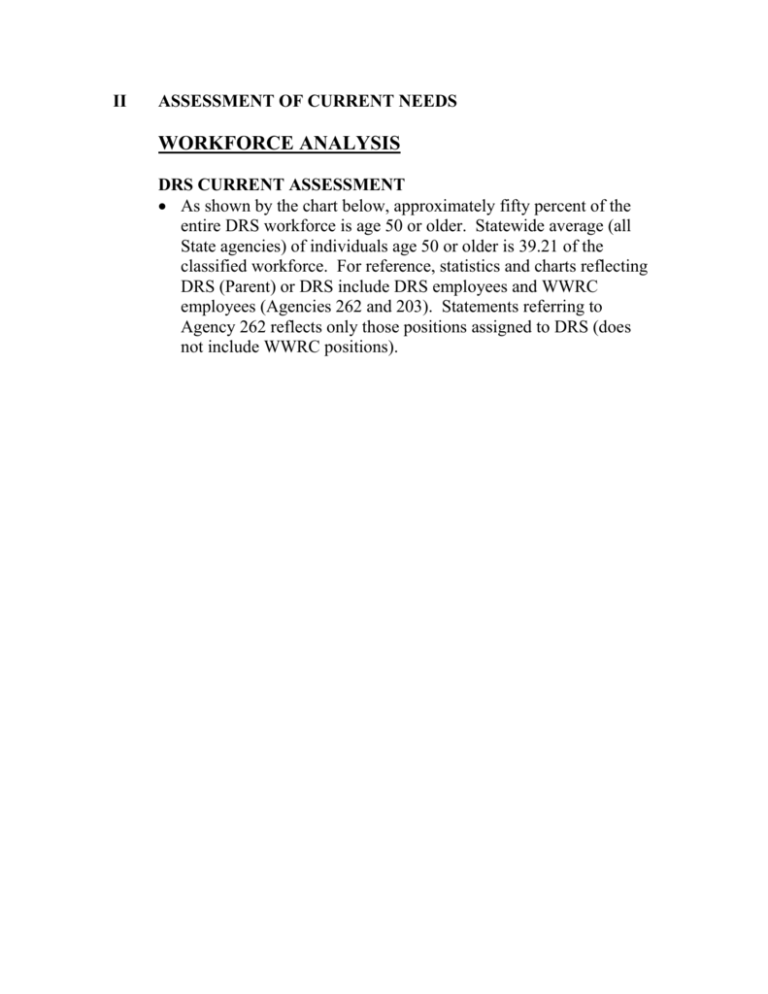
II ASSESSMENT OF CURRENT NEEDS WORKFORCE ANALYSIS DRS CURRENT ASSESSMENT As shown by the chart below, approximately fifty percent of the entire DRS workforce is age 50 or older. Statewide average (all State agencies) of individuals age 50 or older is 39.21 of the classified workforce. For reference, statistics and charts reflecting DRS (Parent) or DRS include DRS employees and WWRC employees (Agencies 262 and 203). Statements referring to Agency 262 reflects only those positions assigned to DRS (does not include WWRC positions). DRS (PARENT) STATISTICS REFLECT BOTH DRS AND WWRC EMPLOYEES 2 A comparison of demographic information for DRS as compared to the Statewide demographic information indicates: o Statewide percentage of Black and Hispanic employees is higher than that of DRS. DRS, however, has a higher percentage of American Indian and Asian employees. DRS (PARENT) STATISTICS REFLECT BOTH DRS AND WWRC EMPLOYEES. 3 o Approximately seventy-three percent of DRS employees are female compared to approximately fifty-three percent for Statewide figures. DRS (PARENT) STATISTICS REFLECT BOTH DRS AND WWRC EMPLOYEES. 4 Resignations of DRS employees total .1 percent of total workforce versus a Statewide percentage of .2 percent. The percentage of the workforce leaving DRS due to better jobs or leaving area is higher than the Statewide percentages. DRS experienced a reduction of 2.4% of the workforce through retirements versus a Statewide reduction rate of .9%. DRS (PARENT) STATISTICS REFLECT BOTH DRS AND WWRC EMPLOYEES. 5 DRS (PARENT) THESE STATISTICS REFLECT BOTH DRS AND WWRC EMPLOYEES. 6 AGENCY 262 SUPPORT STAFF CURRENT ASSESSMENT One hundred and seventeen positions assigned to Agency 262 (Department of Rehabilitative Services) are support staff. Agency 262 Support Staff provides Human Resources, Fiscal, Procurement, Policy and Planning, and other support services for Agency 262 (Department of Rehabilitative Services) , 263 (Virginia Rehabilitative Center for the Blind), 606 (Virginia Board for People with Disabilities), 702 (Department of the Blind and Vision Impaired), and 751 (Department for the Deaf and Hard of Hearing). More than half the employees are over 50 years old. About 1 in every 4 employees is over 55 years old. More than 1 in 5 employees (greater than 20%) is over 50 years old with 25 years or more of service in 2004. Nearly 1 out of every 6 employees (over 15%) is at or above 30 years service in 2004. One in every 5 employees (20%) will pass 30 years service in 2007. There are significant opportunities for employees to take reduced pensions over the next few years. About half of the Support Staff employees will be eligible for either reduced or unreduced benefits in 2004. The statistics for the Agency 262 Support Staff are reflective of the Agency as a whole. For the Total Agency 262, about half of the workforce is over 50 years old. About 1 in 4 is over 55 years old. Nearly 1 out of every 3 has greater than 30 years service. One in every 5 employees will be eligible for unreduced benefits by 2005. A significant threat of increased retirements exists due to the combination of reduced and unreduced pension eligibility, along with an aging population of employees. This is true for both the Agency as a whole, and the Support Staff. 7 Percent of Years Service for Agency 262 Support Staff 0.35 32% 32% 0.3 0.25 0.2 15% 13% 0.15 8% 0.1 0.05 0 Less than 10 Years of Service 10 to 20 Years of Service 20 to 25 Years of Service 25 to 30 Years of Service More than 30 Years of Service Percent Spread of Age of Workforce forAgency 262 Support Staff 35% 30% 25% 20% 15% 10% 5% 0% ov er 60 60 A ge 55 to 55 ge A A ge 50 to 50 to 40 ge A A ge 26 to 40 Percent 8 DDS CURRENT ASSESSMENT Currently, the DDS has 20 employees with 30 years or more of service to the State. This represents approximately 6% of the division’s employees. In addition, there are 142 out of 303 (47%) employees who are age 50 or older. This demonstrates a significant staffing challenge to this agency within the next few years. In reviewing individuals eligible for retirement within the next year it appears DDS could lose 22.7 percent of disability examiners. DDS Vacancies - February 2004 12 10 Number of Vacancies 8 Current Classified Vacancies Current Wage Vacancies 6 4 2 0 Administration Office Medicaid Central Regional Tidewater Office Regional Office Southwest Regional Office Northern Regional Office Location 9 DDS Classified Vacancies by Work Title & Location Medicaid Tidewater QA Specialist PST Unit Support PST Case Developer OSS Unit Sup Case Control Office Services Specialist Fiscal Technician Disability Analyst CE Scheduler Location Southwest Central Northern Admin 0 1 2 3 4 5 6 7 Number of Vacancies DDS Wage Vacancies by Title & Location Medicaid Tidewater QA Specialist PST Unit Support PST Case Developer OSS Unit Sup Case Control Office Services Specialist Fiscal Technician Disability Analyst CE Scheduler Location Southwest Central Northern Admin 0 1 2 3 4 5 6 7 8 Number of Vacancies 10 FRS CURRENT ASSESSMENT The average age of FRS employees is 49 years. The average years of service for FRS employees is 16.9. Thirty-four percent of employees have less than 10 years of experience. This is approximately the same percentage of employees with 25 or more years of service. The average salary is $41,998. These demographics are consistent with those for the agency as a whole. Turnover is an issue for certain positions and for certain locations. Positions that are subject to turnover are VR counselors, specialty counselors, including substance abuse and long term mentally ill, rehabilitation counselors for the deaf and placement counselors. Persons leaving these positions report a variety of reasons for separation including transfers to other positions within the agency, retirement, moving to other agencies for higher pay, particularly to school systems, the Veterans Administration or the federal government. Turnover has been particularly disruptive to service delivery in Northern Virginia where an abundance of better paying jobs. One concern as we look ahead is that new employees will not have the commitment and job loyalty that was often characteristic of employees who are now approaching retirement age. Literature tells us that young employees will not stay in jobs for a lifetime. The rate of vacancies is expected to increase. 11 Breakdown of FRS Positions 9.6 7 13 26 4 7.1 12 54 5 30 20 9 198 Vacancies Part-time Regional Directors Lead Counselors PSTS Rehabilitation Engineer All Other Long Term Disability Central Office (includes ESU & OESSP) Counselors Vocational Evaluators OSS Business Development Specialists One of the most significant changes in FRS structure has to do with the composition of the hierarchical layers. At all levels clerical support has been significantly reduced. At the field office level changes are noticeable in the increase in direct service staff as the ratio of clerical to direct service staff has declined. Increases in numbers of program support technicians senior, in placement counselors and specialty counselors, specifically substance abuse and long term mentally ill counselors, have increased the number of direct service providers. The number of field managers has declined from 21 in the late 1990s to 17 currently. Two of the five regional directors also function as field managers. 12 Demands on field managers have multiplied in response to Disability Services Board initiatives, mandated involvement with local Workforce Investment Boards and One-Stop service centers, partnerships with local school systems, partnerships with departments of social services to collaboratively serve TANF recipients and expanded collaborative relationships with other community partners. Turnover in direct service delivery positions places additional demands on managers as they must manage vacant caseloads to ensure continuity of services to consumers on vacant caseloads. There are fewer managers now than in the recent past and their duties are significantly more far reaching. Changes have occurred in the regional offices as well. For much of the 1980s and 1990s, regional offices were staffed with a regional director and support staff, rehabilitation engineers, marketing specialists, regional training coordinators, and vendor services specialists. Regional directors managed these employees who had region wide impact upon the coordination of a regional network of service providers and on community outreach. For a time both marketing and rehabilitation engineering staff reported to managers outside of the division. These positions now have returned to regional director supervision. Regional directors continue to oversee all regional VR operations, to provide a linkage between central office administration while customizing services and programs to fit needs and resources of the regions. They manage the allocation of internal resources including personnel, case service and administrative funds with little of the manpower that previously existed to assist them. Like field managers, regions directors now exercise a much broader role in developing and maintaining relationships with a variety of community service partners, some mandated partners, and some which create opportunities to blend fiscal resources and extend direct service capacity. Like field managers, regional directors have more responsibility and less support to carry it out. 13 At the same time that field and regional offices have refocused resources on direct service priorities, VR management in the central office has gotten leaner. No longer is there a VR director, an operations manager, a business manager, and a marketing and rehabilitation engineering manager. Productivity has not suffered significantly as a result of reducing regional and central office resources. The VR program continues to serve more than 25,000 consumers each year with approximately 4,000 consumers achieving a satisfactory employment goal each year. Field offices report issues related to support staff coverage. The issues differ from small offices in which there may be only one office services specialist, to large offices with more support and with competing demands. Just the logistics of assigning coverage when the office service specialist is out for a short time can be difficult; it can be extremely disruptive when short or long term absences occur. In Northern Virginia many of the support staff are contract employees. Turnover tends to be high in these offices and training new employees is a recurring drain on existing support staff resources. WWRC CURRENT ASSESSMENT WWRC currently has 23 staff members who are eligible to retire. Of these 23 there appears to be an equal distribution of professional and paraprofessional positions. Only 2 of the 23 positions are nursing positions; consistent with national trends it is anticipated that filling these nursing positions will be challenging. In addition to the difficulty recruiting nursing staff, it is even more difficult to find qualified nurses with experience in rehabilitation. The remaining 21 employees are instructors, trades staff, clinical, administrative and information services staff. Recent pools would suggest that an adequate supply of workers are available to meet the demands of these jobs. Of lesser certainty is the degree to which new workers can perform at a level currently being provided by these veteran staff with 30 plus years of experience. Also an issue of concern is the differing generational work characteristics found in the typical entry level worker as compared to the current veteran staff. 14 WWRC currently has 56 staff members who will be eligible to retire in 5 years. Of these 56 there appears to be an equal distribution of professional and paraprofessional positions. Eleven of the 56 positions are nurses or attendants: consistent with national trends it is anticipated that filling these nursing/attendant positions will be challenging. In addition to the difficulty recruiting nursing staff, it is even more difficult to find qualified nurses with experience in rehabilitation. The remaining 45 employees are instructors, trades staff, clinical, administrative and information services staff. Recent pools would suggest that an adequate supply of workers are available to meet the demands of these jobs. Of lesser certainty is the degree to which new workers can perform at a lever currently being provided by these veteran staff with 30 plus years of experience. Also an issue of concern is the differing generational work characteristics found in the typical entry level worker as compared to the current veteran staff. As of December 2003, 51.19% of classified WWRC employees are age 50 or older as compared to a Statewide percentage of 39.21%. In reviewing turnover data for WWRC, the percentage of resignations due to better job opportunities or dissatisfaction on the part of the employee is higher than the Statewide average. All Center medical staff receive an intensive orientation to medical and therapeutic rehabilitation practice. An active in-service program provides continuing professional growth. This highly specialized level of service attracts nursing and therapy affiliates from colleges & universities and technical schools throughout the United States. Retirements (service, in lieu of layoff and enhanced retirements) percentage for WWRC is higher that the Statewide average. 15 RECRUITMENT INFORMATION DRS RECRUITMENT Vacancies are listed with the RECRUIT listing which is a Statewide system for capturing all State vacancies. This listing is available for review through the Internet and is accessible by visitors at Virginia Employment Commission locations throughout the State. Vacancies are also listed on DRS’ website and are distributed to over eighty organizations/facilities including organizations dedicated to assisting minorities, females and individuals with disabilities. Advertising is somewhat limited, in that budgeting for advertising expenses was significantly reduced over a year ago. Advertising now is composed of small ads with limited information including direction to the agency’s web site address for full details about the opening and mailing lists. The Disabilities Services Agencies’ web site is in development to include a Career Center. Currently, the web site includes an introduction to applicants that expresses values shared by the agencies and an introduction into the agency’s culture. It briefly describes the types of positions within the agency and provides a job listing for all available positions. Project plans for the Career Center include: employee snapshots which provide employee vignettes of their job requirements and their personal motivation, tips for applying for positions and on interviewing skills, benefits to employees, and information about working in Virginia. Additional activities include enhanced New Employee Orientation linked to the Career Center. Human Resource Intranet pages are being updated to provide employees with easily accessible information. DDS RECRUITMENT ISSUES Currently all recruitment and hiring has been suspended per orders from Social Security Administration due to the Continuing Resolution issued by Congress. 16 DDS experiences difficulty in recruiting in the following areas: o Northern Virginia and Central Regions - contract clerical staff positions are difficult to fill due to low skill level o Northern Virginia Region - supervisors/case consultants due to limited pool of experienced/professional staff o Tidewater Region - analyst positions o Southwest Region - analyst positions due to lack of applicants with knowledge, skills and abilities and noncompetitive salary FRS RECRUITMENT ISSUES Some significant changes have been noted in applicant pools. There are significantly fewer applicants for VR counselor and vocational evaluator positions. Frequently the qualified applicants, those that are screened in for consideration, are recent graduates from master’s programs. In many cases they are the best qualified candidate, but they lack relevant experience. Training new employees in these positions is time consuming for the manager and/or other staff, and it takes a long period of time before a new employee can function independently. Experience has shown that it is more difficult to fill vacant positions with qualified applicants in rural areas of the state. The far Southwest, the Winchester area and the Southside area including South Boston, Danville and Martinsville are locations that have had difficulty attracting qualified candidates. Also difficult to attract, but in great demand, are employees with special communication skills. At one time this need applied only to sign language interpreters. Increasingly it applies to foreign language speakers that are needed to communicate with the diverse populations served by FRS. 17 The FRS workforce has undergone significant change with respect to competencies and credentials. Federal legislation established new Comprehensive System for Personnel Development (CSPD) standards for rehabilitation counselors and vocational evaluators. Both are required, by 2008 to have Masters Degrees in rehabilitation counseling or a closely related field or to be eligible to sit for the Certified Rehabilitation Counselor or Certified Vocational Evaluator examination. Since 1999, 59 FRS employees completed or are about to complete a master’s program with funding provided by DRS. Ninety-seven other counselors and 9 vocational evaluators are certified counselors or evaluators. We have a workforce serving consumers that is better qualified and more knowledgeable than ever before. The higher standards for qualified personnel surely contribute to better services for consumers. It does, however, create difficulties in finding qualified candidates. The size of applicant pools for counselor positions has decreased remarkably and it is not unusual to advertise multiple times before attracting a reasonable pool of applicants. Finding qualified vocational evaluators and rehabilitation engineers is challenging as there are few with the training and experience to perform these jobs. WWRC RECRUITMENT ISSUES Recruitment for nursing personnel (registered nurses, licensed practical nurses and nursing assistants) is problematic and consistent with national trends. Attracting applicants with experience in rehabilitation is also difficult. OTHER WORKFORCE ISSUES New regulatory changes will create a shift in the type of workforce within DDS. Analyst caseload management and analyst quality are issues affecting Central, Northern, Southwest and Tidewater Regions of DDS. 18 All the new strategies for claims adjudication being proposed by SSA would be fully funded by that agency and would not, therefore, impact the state agency’s capital or financial plans. No plans for De-emphasis or Discontinuance of this agency – New regulatory changes will create a shift in the type of workforce within the DDS. FRS has many examples of mobile workers in the field. It is customary for counselors to spend large amounts of time at itinerary sites that may include One-Stops, schools, departments of health or social services, Community Services Boards and Clubhouses. Technology to support mobile workers is improving, but continues to be a challenge. We can expect more mobility in the future. Employees must have network access to be efficient in performing work in a variety of locations. The division will explore options and strategies to make telecommuting an option for those who can be as productive or more productive in alternate work sites. In the fall of 2003 a team of staff from the DRS Central Agency evaluated WWRC and provided a written report about the structure and effectiveness of the Center. A new Center Administrator, Dr. Richard S. Luck, was assigned to WWRC on August 1, 2003, to oversee the implementation of the Study Team's recommendations. As of the writing of this report the majority of those recommendations have been implemented. WWRC will finish the current fiscal year with a slight budget shortfall but will begin fy05 with a balanced budget for the first time in many years. Conduct issues are monitored through the WWRC HR Office but do not appear to be a cause for concern at the present time. There are no indicators that would suggest that an increase is anticipated. To the contrary, WWRC employees are performing at a "contributor or exceeds contributor level." There is no established pattern of employees performing below the contributor level. 19 TRAINING ISSUES DDS Current Training Needs o Supervisory Training Including Interpersonal Skills for Unit Supervisors as they have to deal with lots of different personalities and they need to be able to communicate effectively with all their analysts. o Eview Training o Medicaid claims adjudication training o Individualized training for career advancement o Training in adapting to constant change o Caseload management in the Levy environment o Interviewing skills for supervisors o Software specific training (e.g. Word, Windows and Excel) FRS Current Training Needs o New Counselor Skills Training o Vocational Evaluator’s Training o Job Development and Job Placement o Conflict Resolution o Caseload Management o Core Skills Training o Critical Thinking Skills for Managers o Serving persons with head injuries o Disability specific training o Support Staff Training o Automation Training o Students in Transition o Safety in the Workplace o Leadership Skills o New Supervisor’s Skills 20 WWRC Dr. Luck developed a Leadership Coalition that has completed an analysis of the operational environment and has determined that the primary training need is for "change management and leadership training." Wayne Heatwole, Director of the Office of Management Support at WWRC, who monitors training has identified that an initiative to support behavioral intervention, especially a train the trainer model, is needed. DRS RECOGNITION PROGRAM In 2001 a committee was formed to develop a proposal for a employee recognition program for the Department of Rehabilitative Services. This workgroup was made up of employees representing the major functional areas within DRS and solicited input from all DRS employees in developing a proposal. Based on input from employees, a formal Employee Recognition Program was implemented in January 2002. A copy of the Employee Recognition Program Policy is included in our appendix. In 2002 awards totaling $10,515 were received by DRS employees. In 2003, $8,979.57 was spent on recognition awards during the first two quarters. Due to budgetary constraints, monetary awards were discontinued and recognition leave was awarded. Approximately 600 hours of recognition leave was awarded during the last two quarters of 2003. As a result of feedback from the Employee Recognition Team, beginning January 1, 2004, the number of awards allowed by our program increased to a maximum number of 268 awards allowed each year. This will provide more opportunity to recognize those employees making a difference in our agency. 21
